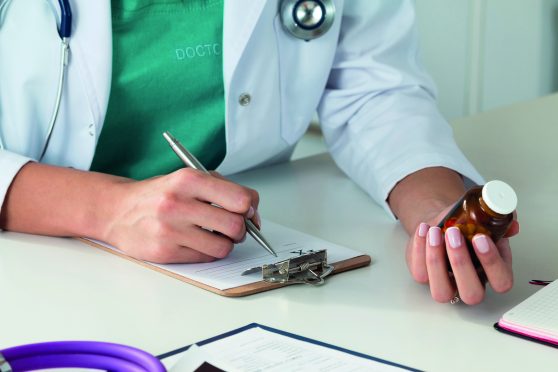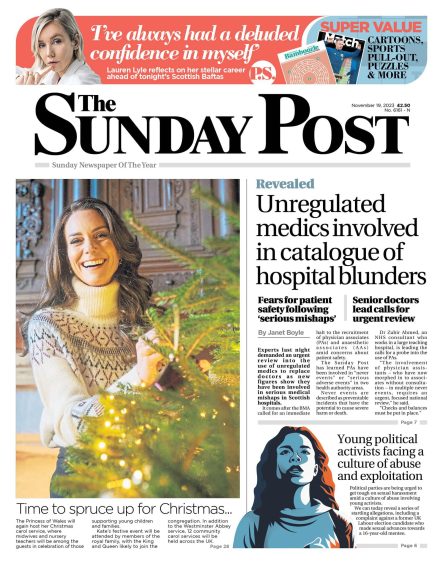
A junior doctor has revealed she was pressured by a physician associate at a Scottish hospital to sign prescriptions for stroke patients.
The doctor says she was asked to approve drugs because the physician associates (PAs) are not allowed to as it is above their remit and responsibility.
It follows a survey by a leading UK doctors’ organisation that PAs – unregulated medics’ assistants – are acting above their professional boundaries, including coercing junior doctors to prescribe drugs.
The junior doctor was working in the stroke unit at Aberdeen Royal Infirmary (ARI) when she was leant on by a PA to prescribe drugs. She says she stood her ground and refused.
A survey by Doctors Association for the UK (DAUK) revealed in The Sunday Post, contained complaints that inexperienced junior doctors in training were being coerced to sign off prescriptions for PAs. One patient came to harm.
The junior doctor, who left medicine, said: “I was a young doctor working in the stroke unit of ARI and felt under pressure to take prescribing advice from a PA despite them not being qualified to do this.
“I did not take this advice as the ultimate responsibility lay with me, being a prescriber, but I can see how new doctors may feel pressured into agreeing.
“The responsibility would be mine if the decision was wrong. This is one of the reasons I left medicine because of intolerable pressure and I now work in business.”
The DAUK survey of more than 680 UK doctors reported feedback from Scottish hospitals including missed cerebral haemorrhages (brain bleeds) and attempts to examine unresponsive patients who instead desperately needed treatment to breathe.
Freedom of Information requests to health boards by The Sunday Post revealed at least 12 Never Events (dangerous near-misses to patients) involving PAs.
Leading doctors’ organisations are calling for clarity in boundaries for PAs.
The Royal College Of Physicians of Edinburgh (RCPE) has recommended renaming physician associates to the internationally recognised term “physician assistant”, which they say would help avoid confusion for the public with existing medical roles such speciality and associate specialist (SAS) doctor, who have the same clinical experience as a consultant but have not completed specialist training.
The junior doctor described her job at ARI as intolerable and called for clear boundaries in PAs roles.
“It was also normal for the PA to carry the pager for the stroke unit. This means attending A&E to assess patients suspected of having a stroke. The consultant would read the scans.
“All throughout medical school it is impressed on us to know our boundaries based on training and experience.
“I am unsure of the extent to which PAs receive this.
“I also experienced a PA interrupting with answers when I asked doctors in a staff room setting about guidance on treating patients.
“It seemed like some PAs were more aware of their remit and conscious of working within this than others, which I felt was a potential concern for patient safety
“It probably happens because of their role being less well defined or regulated than those of doctors and nurses.
“It was very stressful and often a difficult work culture and it impacted my ability to enjoy life outside of work as a result, which was ultimately why I left.
“I think the NHS is losing a lot of good doctors. It is an interesting and rewarding job and I would have been far less likely to leave if it had not had so many negative, often avoidable, experiences.”
Less than a third of junior doctors now move on to year three of their junior doctor training pathway after completing their second. They either take a break or leave altogether.
A recent survey by the Association of Surgeons in Training (ASiT) reported this month that 70% of respondents reported a negative impact from PAs. It was the largest survey in ASiT’s 48-year history.
The RCPE’s statement last week said that PAs are not doctors and must not be treated as substitutes for doctors.
It adds that regulating them is vital to ensure quality management, training and a career path for them.
The General Medical Council (GMC) says it will regulate PAs this year, and also finalise their fees. Last week, Andrew Stephenson, Minister for Health and Secondary Care, suggested PA’s, who earn £45,000 a year, could pay membership fees of £221 per annum.
GMC fees for doctors are £433 with discounts of more than 60% for newly qualified doctors on around £28,000 and 50% on those earning under £34,000.
NHS Grampian said: “We cannot comment on this individual’s experience. Speaking generally, we have a range of avenues for people to report concerns about their duties, the duties of others, and the behaviour of their colleagues.
“When someone leaves the organisation, they are offered an exit interview. This is an opportunity for them to raise any issues they have experienced.
“PAs are an important, valued, and long-standing part of the NHS Grampian workforce.”

Enjoy the convenience of having The Sunday Post delivered as a digital ePaper straight to your smartphone, tablet or computer.
Subscribe for only £5.49 a month and enjoy all the benefits of the printed paper as a digital replica.
Subscribe